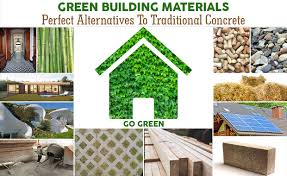“`html
The Future of Construction: Sustainable Building Materials
In recent years, the construction industry has been shifting towards more sustainable practices to reduce its environmental impact. One key aspect of this movement is the use of sustainable building materials. These materials are not only eco-friendly but also offer various benefits in terms of durability, energy efficiency, and overall building performance.
Benefits of Sustainable Building Materials
Sustainable building materials are sourced and manufactured in a way that minimizes resource depletion and environmental degradation. They often have lower carbon footprints compared to traditional materials, contributing to a healthier planet. Additionally, these materials are known for their longevity and resilience, reducing the need for frequent replacements and maintenance.
Types of Sustainable Building Materials
There is a wide range of sustainable building materials available in the market today. Some popular options include:
- Bamboo: A rapidly renewable resource that is strong, lightweight, and versatile.
- Recycled Steel: Made from scrap metal, recycled steel is durable and can be reused multiple times.
- Rammed Earth: A traditional building material that offers excellent thermal mass properties for energy efficiency.
- Cork: Harvested from cork oak trees without harming the environment, cork is a great insulator and acoustic material.
- Reclaimed Wood: Salvaged from old structures, reclaimed wood adds character and sustainability to new construction projects.
The Future Outlook
As awareness of environmental issues grows, the demand for sustainable building materials is expected to rise. Architects, builders, and developers are increasingly incorporating these materials into their projects to create greener buildings that benefit both occupants and the planet. With ongoing research and innovation in this field, the future of construction looks promising with a focus on sustainability at its core.
By embracing sustainable building materials, we can pave the way for a more eco-conscious and resilient built environment that meets the needs of present and future generations.
“`
5 Tips for Choosing Sustainable Building Materials
- Choose materials with high recycled content to reduce the demand for new resources.
- Opt for locally sourced materials to minimize transportation emissions.
- Select materials that are durable and long-lasting to reduce the need for frequent replacements.
- Prioritize renewable materials such as bamboo, cork, or reclaimed wood.
- Look for certifications like LEED or Cradle to Cradle to ensure the sustainability of building materials.
Choose materials with high recycled content to reduce the demand for new resources.
“`html
One effective tip for promoting sustainability in construction is to choose materials with high recycled content. By opting for such materials, builders can significantly reduce the demand for new resources and minimize waste generation. Using recycled content not only conserves natural resources but also helps divert materials from landfills, contributing to a circular economy. This simple yet impactful choice can play a vital role in creating more environmentally friendly and resource-efficient buildings.
“`
Opt for locally sourced materials to minimize transportation emissions.
“`html
Choosing locally sourced materials is a smart strategy for promoting sustainability in construction projects. By opting for materials that are sourced nearby, builders can significantly reduce transportation emissions associated with long-distance shipping. Not only does this help lower the carbon footprint of the building process, but it also supports the local economy and reduces reliance on fossil fuels. Embracing locally sourced materials is a practical way to enhance the environmental performance of construction projects while fostering community resilience and reducing environmental impact.
“`
Select materials that are durable and long-lasting to reduce the need for frequent replacements.
“`html
When choosing sustainable building materials, opting for options that are durable and long-lasting can significantly contribute to reducing the need for frequent replacements. Not only do these materials offer longevity and resilience, but they also help minimize waste generation and resource consumption over time. By selecting materials that stand the test of time, builders can create structures that are not only environmentally friendly but also cost-effective in the long run.
“`
Prioritize renewable materials such as bamboo, cork, or reclaimed wood.
“`html
When it comes to sustainable building materials, prioritizing renewable options like bamboo, cork, or reclaimed wood can have a significant positive impact on the environment. These materials are not only eco-friendly but also offer unique properties that enhance the overall quality of construction projects. Bamboo, known for its rapid growth and strength, provides a versatile and durable alternative to traditional wood. Cork, harvested without harming trees, serves as an excellent insulator and acoustic material. Reclaimed wood not only adds character to buildings but also reduces the demand for new timber, promoting resource conservation. By choosing renewable materials like bamboo, cork, or reclaimed wood, builders can contribute to a more sustainable and greener future for the construction industry.
“`
Look for certifications like LEED or Cradle to Cradle to ensure the sustainability of building materials.
“`html
When selecting building materials for construction projects, it is essential to prioritize sustainability. One valuable tip is to look for certifications such as LEED (Leadership in Energy and Environmental Design) or Cradle to Cradle to guarantee the eco-friendliness of the materials used. These certifications indicate that the materials have met specific criteria for environmental performance, resource efficiency, and overall sustainability. By choosing materials with recognized certifications, builders can ensure that their projects align with best practices in sustainable construction and contribute to a greener future for the built environment.
“`

